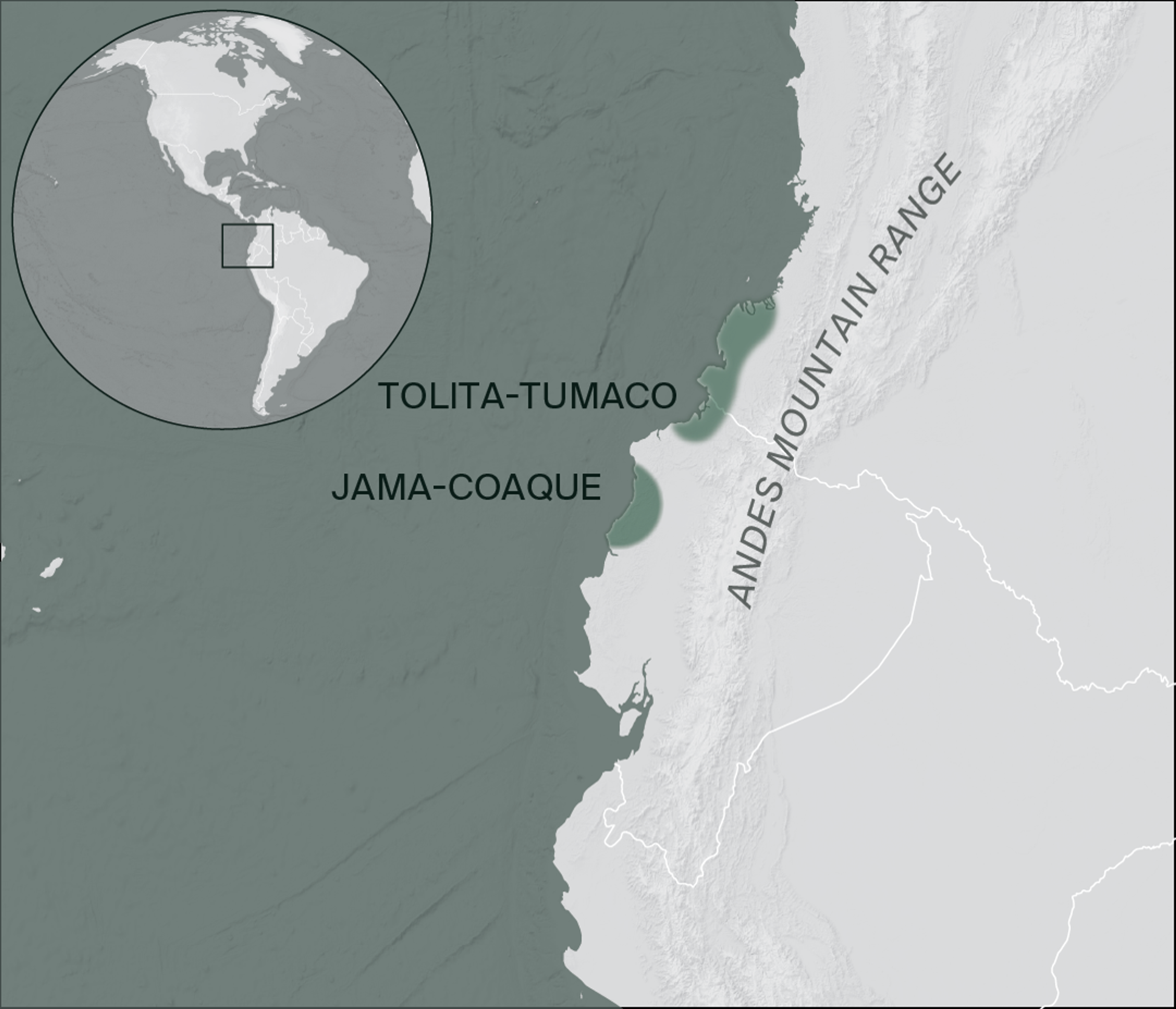Lea este ensayo en español: Representaciones del poder en el pasado de la costa del Ecuador
The landscape of the Northern Andes—today Ecuador and Colombia—is a mix of valleys surrounded by mountains and tropical ecosystems (see map). In this environment, archaeologists have found evidence of some of the oldest complex societies in the Americas, dating to as early as 3500 BCE. Known collectively today as the Valdivia culture, these ancient societies established agricultural economies that sustained the formation of large permanent villages, such as Real Alto. In these settlements, large enclosures and mounds served as stages for ceremonies and rituals performed by religious specialists—powerful leaders who became the center of political life for these communities.

Archaeologists recognize multiple cultural traditions in coastal Ecuador during the period between 300 BCE and 600 CE. These are known today as the Tolita-Tumaco, Jama-Coaque, Bahía, Daule-Tejar, and Guangala cultures. In these societies, probably representing multiple political entities, most people lived near the mounds that served as the residences of the rulers and their families. A Tolita-Tumaco ceramic sculpture depicts one of those powerful chiefs, a man whose wrinkled face denotes his advanced age. Such elders would have possessed unrivaled power based on their ample life experience, long history within their communities, and large network of kin and followers. This effigy, however, reveals another dimension of the elder’s authority. His protruding eyes signify the expression of a person in a shamanic trance, a state in which these chiefly priests purportedly transformed into a jaguar or other animal-like beings.
Similar shamanic practices are known in many contemporary societies in the neotropics, often involving the consumption of beverages made from hallucinogenic plants and roots. The vine Banisteropis caapi—also known as ayahuasca, yagé, or nepe—is one of these plants still widely used today among South American shamans. The intake of these substances is part of a sophisticated cosmological system where shamans are seen to transform into human-animals, plants, and other non-human beings. A Tolita-Tumaco bone sculpture mixes feline and human features and likely depicts a shaman’s visions during such a state of altered consciousness.
South of the Tolita-Tumaco area, artists of the Jama-Coaque culture mastered the creation of fine ceramics with complex representations of personages, quotidian activities, and ceremonial events. These highly sophisticated ceramics suggest that specialized artisans were dedicated exclusively to pottery crafting in these communities. Elites in Ecuadorian antiquity can be identified by their lavish adornments , the details of which may allow us to differentiate between political and religious leaders. In Jama-Coaque society, priests were usually represented carrying ritual paraphernalia , while political leaders known as caciques or curacas are shown carrying a staff known today as a bastón de mando (staff of power). This difference may indicate a separation between political and religious authority.
Further south, Bahía and Guangala potters also represented the caciques and priests with their particular accoutrements , with some sculptures from Bahía almost life-size. The jewelry depicted in these sculptures was often made from the same metals as the trappings that community leaders actually wore ; . Ornaments of gold, silver, and tumbaga (a gold-copper alloy) seem to have been reserved for members of the elite, while copper objects were worn by lower-ranked individuals.
By the early sixteenth century, the communities of coastal Ecuador had gradually unified into confederacies that constituted a regionally integrated network of chiefdoms. Three of the larger polities were the Manteño culture and the Punaes on the Pacific coast and Milagro-Quevedo cultures in the interior. Ethnohistorical sources point out that the Manteño people participated in long-distance trade that connected the northern coast of South America with Mexico, and archaeological work confirms that these chiefdoms formed a large commercial network along the Pacific coast. Traveling by balsa rafts, these communities controlled sea routes as well as the manufacturing and distribution of goods fashioned from coastal resources, especially Spondylus shell. Inland, the large Guayas River Basin was home to the Milagro-Quevedo communities, which were hierarchically organized into constellations of villages. The caciques lived in large settlements with multiple mounds, sometimes more than a hundred, surrounding a central plaza. The region’s alluvial plain, constantly exposed to floods, provided these communities with large quantities of mud, which was used to build one of the most impressive raised-field agricultural complexes of the Americas. Both the mounds and the earthworks required the assembly and management of very large labor pools.
By 300 BCE, a key feature appears in both the pottery and stone media of the region: the seated figure. The scholar Colin McEwan performed a meticulous analysis of these representations in 2003 and concluded that in tropical lowland societies of South America and the Caribbean region, throne-like seating was intimately related to power. Chiefs occupied a central position in rituals and are usually represented seated . In the later Manteño society (700–1500 CE), chairs sculpted from stone have been found exclusively at regional centers such as Cerros Hojas-Jaboncillo and Agua Blanca in coastal Ecuador. There, the stone seats were found placed parallel to the sides of buildings or in circles. These sillas manteñas (Manteña chairs) consist of a U-shaped seat supported by a carved body representing a person, an animal such as a jaguar, or a mythical creature.
Seats remain associated with power among the ethnographic groups of South America and the Caribbean today. In Amazonian communities, for example, the chief is always found seated on a stool placed in a central location in the main plaza or inside the central communal habitational house, called a maloca, during public events. These modern-day seats are made from ceramic, wood, and stone and are adorned with animal figures, especially jaguars and caimans, just like their ancient counterparts.